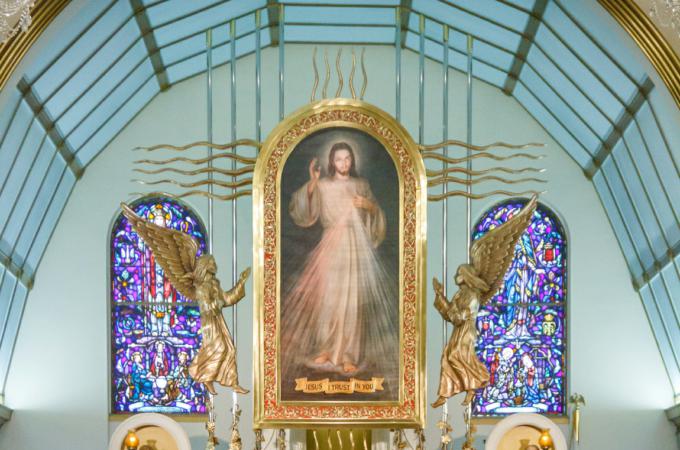Cardinal celebrates feast of Divine Mercy at Salem shrine
SALEM -- Cardinal Seán P. O'Malley visited the St. John Paul II Shrine of Divine Mercy for the celebration of Mass on April 11, Divine Mercy Sunday.
Formerly St. John the Baptist Polish Church, the St. John Paul II Shrine of Divine Mercy emphasizes the contributions of two Polish saints: St. Maria Faustina Kowalska, who received the commission of the Divine Mercy image in her visions of Christ, and St. Pope John Paul II, who instituted the Sunday after Easter as the feast of Divine Mercy.
Concelebrating the Mass with the cardinal were the shrine's rector, Father Robert Bedzinski, S.Chr., and Father Jacek Walkiewicz, provincial of the Society of Christ Fathers for Poles Living Abroad, which ministers to the Polish diaspora. The celebration concluded with the recitation of the Divine Mercy Chaplet.
In his homily, Cardinal O'Malley spoke about Christ's appearances after the Resurrection and demonstrations of mercy, which the cardinal said is "at the heart of the Gospel."
He spoke about how, on Good Friday, the shepherd, Jesus, was struck and his sheep, the disciples, were scattered. Mary Magdalene was scattered in her grief; the disciples journeying to Emmaus were scattered by fear; Thomas was scattered in his doubt; Peter was scattered in denial. But on Easter Sunday, the Good Shepherd returned to gather the scattered sheep.
"All of us, in our own lives, in so many ways, are scattered by our weaknesses, our failures, our sickness, the loss (and) the sufferings of this pandemic. And in the midst of all of this, the risen Lord comes back to gather us to himself," Cardinal O'Malley said.
During these post-resurrection appearances, he said, Christ teaches that he will always be with his people -- not just in a certain period in history or location in the world, but in all times and places.
"Jesus is our contemporary. He is with us. He is alive, and he is gathering us to himself," Cardinal O'Malley said.
He pointed out the times after the Resurrection when Jesus showed his presence through the sacraments. In Emmaus, he made himself known in the breaking of bread. In the upper room, he told the apostles that those whose sins they forgave would be forgiven. Before his ascension, his last instruction to his disciples was to go and baptize.
"The Lord is present in the sacraments, always and everywhere, present where two or three are gathered in his name, present where we, in mercy, take care of the hungry and the poor and the sick," the cardinal said.
He also drew attention to St. John's description of how Jesus entered the upper room, where the disciples were hiding despite the locked doors.
"We cannot lock Jesus out of our lives or out of our hearts. He will always find a way in," Cardinal O'Malley said.
He said that when the disciples saw the risen Lord, they were probably excited and happy but also ashamed of how they had fled from his arrest and were absent at his death and burial.
And yet, Cardinal O'Malley said, "Jesus didn't come to rebuke them or to punish them, but to show them his forgiveness, and not only that, but to give them the power to forgive sins, to be instruments of his mercy."



















